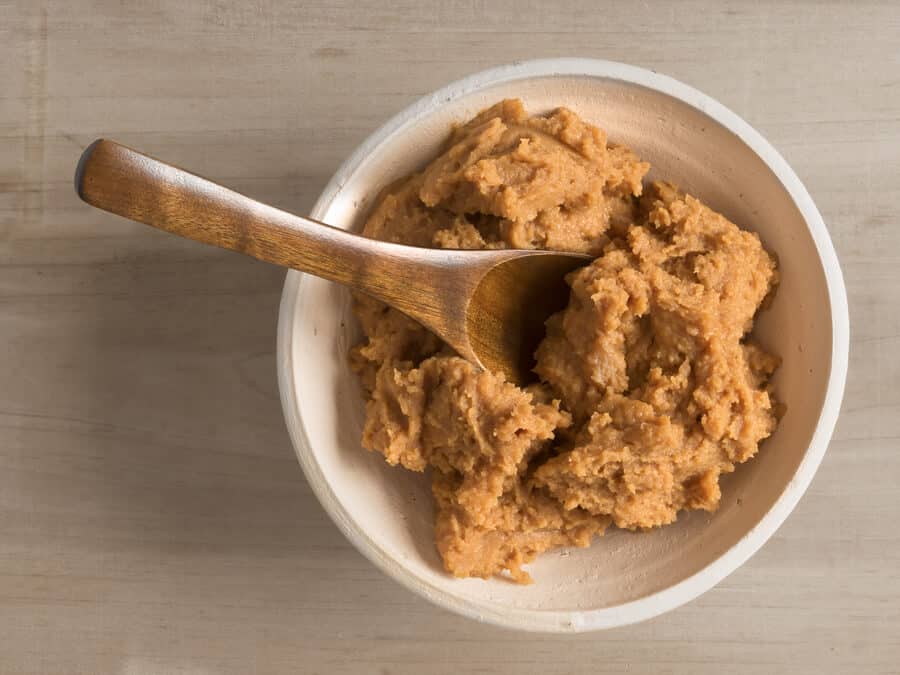
Well, soup, obviously: Start with the classic, then tinker it into chicken noodle miso, kimchi and egg miso, or another variation.īut you probably won’t get through a whole container of miso only making soup. You can also store it in the freezer, which will not change its texture or flavor. You can keep miso in an airtight container in the refrigerator indefinitely, though it may get darker or denser over time. The many varieties of miso How should you store it? Over weeks (or even years!), the enzymes in the koji work together with the microorganisms in the environment to break down the structure of the beans and grains into amino acids, fatty acids, and simple sugars. But what is miso and where does it come from? Let's find out, shall we? Okay, what is it?Īt its most basic, miso is a fermented paste that’s made by inoculating a mixture of soybeans with a mold called koji (for you science folks, that’s the common name for Aspergillus oryzae) that’s been cultivated from rice, barley, or soybeans. We use miso to add a salty savoriness to polenta, to balance the sugariness of caramel, and to give salad dressing an anchovy-free oomph. But if we tell you there's a secret ingredient and you guess miso, you'll probably be right. Sure, the concept of a "secret ingredient" might be kind of silly. Click here to read the whole guide-then stock up. If you try this recipe, let us know by leaving a comment, rating, and tagging a photo #minimalistbaker on Instagram! Cheers, friends.This story is part of the Healthyish Pantry, a collection of articles breaking down the ingredients we love most.

MISO PASTE INGREDIENTS FULL
And for veggie lovers like me, there’s more than a full serving of greens in each bowl. This soup is bursting with miso flavor and delivers the perfect amount of tofu and seaweed in each bite. So I added some green chard and lots of green onion to the mix and couldn’t have been more pleased with the result! I wanted to keep my miso soup super simple and quick, but with a bit more emphasis on the greens.
MISO PASTE INGREDIENTS HOW TO
Learn how to make your own here! However, ours is plant-based and made with vegetable broth, which is not traditional but it’s what we always have on hand.

Traditionally, miso soup begins with a broth called “dashi,” made by soaking seaweed such as kombu in water and cooking with bonito flakes (flakes of dried fermented fish). Miso soup is a traditional Japanese soup made primarily of miso paste, dashi (broth), and additional ingredients such as vegetables, seaweed, and tofu. So, I found it a worthy addition to my pantry. It may seem like an obscure ingredient to buy just for soup, but it’s affordable, incredibly healthy, and can be used in many other recipes like soups, salad dressings, marinades, and many Asian-inspired dishes.

Miso paste can be found in the refrigerated section of most grocery stores and Asian markets. And as a fermented food it also provides beneficial bacteria for the gut. Soy miso also contains phytonutrient antioxidants ( source). Miso is rich in minerals like zinc, copper, and manganese, as well as various B vitamins and vitamin K. Miso has since became a staple in Japanese cuisine, and is made with a variety of ingredients including: Rice in the north, sweet white miso near the capitol of Kyoto, soy in the central Aichi prefecture, and barley in the south. It was made with fermented mixtures of salt, grains, and soybeans and used as a way to preserve food during warmer months. Miso was believed to have originated in China and later introduced to Japan more than 1,300 years ago by Buddhist priests. That, along with a strong sushi craving, inspired me to create some of my own. But when I was feeling a little under the weather recently, miso sounded soooo good to my achy stomach. Up until now I’ve reserved miso for times when we go out to eat. It’s so warm and comforting and savory, with perfect little bites of tofu and seaweed in every scoop. One of my favorite parts of going out for sushi is miso soup.


 0 kommentar(er)
0 kommentar(er)
